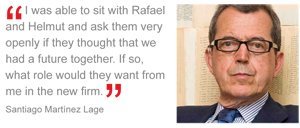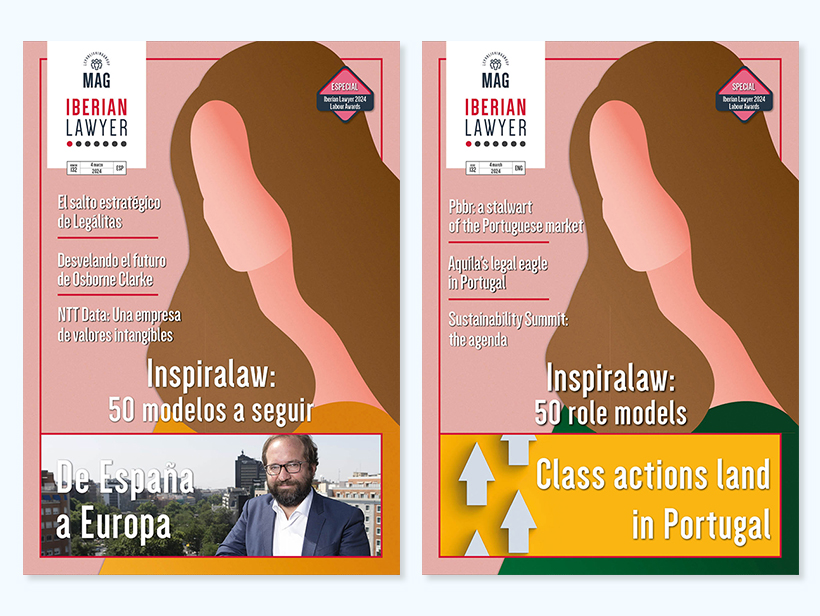All together now
As well as bringing threats, recent years have shown that a crisis can also bring welcome opportunities for change. The challenge for lawyers is, of course, in understanding how best to navigate away from the first while embracing the second.
Considerada por muchos, en los últimos tiempos, como una boutique de Derecho de la competencia, Martínez Lage & Asociados no ha sido inmune al golpe de la economía. Retos en la gestión interna y el colapso de su aliado en EUA, han provocado que el despacho resurja bajo el nombre de Martínez Lage Allendesalazar & Brokelmann, con un nuevo posicionamiento en el mercado para enfrentarse a lo que esté por venir.
At the start of the financial crisis, Martínez Lage & Asociados was not a law firm which many would have associated with change. Widely perceived as Spain’s pre-eminent competition law boutique, its founding father Santiago Martínez Lage – now in his 60s – has been a pioneer of European Union (EU) and competition law within Spain since the country’s accession to the EU in 1986.
He had built a practice which by 2007 had grown to three partners and eight lawyers, and out-scored many of its much larger full-service Madrid peers in the league tables. “The description haute couture is perhaps more appropriate than boutique,” says Martínez Lage himself.
Alongside Rafael Allendesalazar and Helmut Brokelmann, his most loyal and long serving colleagues, Martínez Lage had developed a first class reputation especially relating to complex mergers, state aid, cartels and other anti-competitive behaviour.
Without the management challenges of the big firms, the firm’s lawyers have been well placed to benefit from the growing importance of such issues in Spain. A downside, of course, has been the ceiling on growth – the firm has proved to be a training ground for a generation of competition practitioners, now in other firms.
Bad weather
The announcement in September 2007 of a merger with US firm Howrey came as a surprise to many. That Martínez Lage had, over the years, been pursued by a number of suitors was never doubted. Many were domestic firms hoping to expand their competition practice, though also many leading foreign firms. “Not for sale”, had however until now been the sign hung out.
That a leading US competition firm like Howrey, keen to expand across Europe, was interested in Martínez Lage was of no surprise. Based in Washington DC, Howrey at that time had more than 600 lawyers across 10 offices in the US, five in Europe and one in Asia. Not only was it included in the “A-List”, a ranking of the top 20 US law firms prepared by The American Lawyer, it was often voted the leading global competition law firm.
In contemplating the offer, Martínez Lage says that he could see difficult economic times ahead, joining a firm with clear global aspirations would provide their clients – as well as his own team – with an exciting international perspective.
By autumn 2007 economists had already started to view the impending sub-prime crisis unfolding in the US as a major cloud on the horizon. In Spain too some were beginning to suggest that the party was over. For a niche competition law practice looking for a safe harbour within a strong international firm, Howrey was a strong candidate.
The negotiations were sealed with Howrey, unusually, agreeing to share its name in the new Howrey Martínez Lage, and welcoming Allendesalazar and Brokelmann as full equity Partners alongside Martínez Lage himself.
Looking back on the decision to merge, Santiago says: “We could already tell at that stage that the market conditions were changing. What had been a demand-led market was turning to a supply-led market. We had to turn that disadvantage into an advantage, and so we were excited about being part of a larger referral network.”
The honeymoon was, of course, short-lived but in 2008 nobody could have foreseen the troubles that lay ahead for Howrey. 2009 was a difficult year financially. Reportedly, the firm’s gross revenue fell by 16.3 percent to $480 million, and profits per partner fell by almost 40 percent to $846,053.
After failed merger talks, partners started to vote with their feet with the European practice proving particularly vulnerable. A new pan-European IP outfit emerged out of Howrey just as it was entering into (ultimately failed) merger talks with Winston & Strawn.
Hoyng Monegier began operations at the start of January 2011 having established offices in Amsterdam, Brussels, Madrid and Paris, drawing 19 partners and 30 associates out of Howrey. In Spain, Howrey Martínez Lage lost IP Partners Laura Alonso and Luis Fernández-Novoa to lead its Spanish practice, although Martínez Lage insists that excellent relations remain with his former colleagues.
In an announcement that caused shockwaves across the US legal profession, Howrey finally closed in March 2011. Howrey’s Managing Partner, Robert Ruyak, blamed two new trends for the demise.
First, clients’ demands for fixed and contingency fee arrangements were reducing profit and making cash-flow difficult and less predictable. Like many major firms, Howrey took an annual bank loan in January (reported in the US media as $75m) for rent and salaried employees, which was repaid without difficulty by the yearly client income. However, in this case, default covenants on the repayments were triggered by the growing partner departures, causing the firm wider problems.
Ominously for the profession, Ruyak’s second trend points to the ways in which new technology and non-lawyer providers of legal services were winning work from them in areas like due diligence and through e-discovery.
 A new beginning
A new beginning
Today, Martínez Lage is quick to highlight the positive and not the negative aspects of the merger, taking time to praise the expertise and professionalism of the Howrey partners. Brokelmann and Allendesalazar too share a huge respect for the individuals within the firm, although there were already tensions emerging in the relationship.
“We could see that in the US firms there is a huge pressure around revenue, which can often be reflected in their approach to pricing. As we have always worked hand-in-hand with clients in the most flexible way possible, such a financial approach inevitably proved restrictive for us,” says Martínez Lage.
Behind this, there is also the suggestion that the flow of client referrals was disappointing for such a large network. As a boutique, Martínez Lage & Asociados had enjoyed a high flow of international law firm referrals which ended with the Howrey deal. With the tap closed on some important sources of work Howrey was not able to compensate.
On balance the experience was beneficial, they say. For Allendesalazar: “They were all great lawyers at Howrey and, as they have moved on to new firms, we have benefited from a much wider network of contacts.”
The fall-out from the collapse of Howrey was however the rebirth of the firm in Spain and a new partnership, Martínez Lage, Allendesalazar & Brokelmann, which was announced to the world in March 2011.
Meeting with the three “founding partners” of the new firm, it is easy to believe that they have emerged as a stronger unit. And while Martínez Lage is keen to emphasise the continuity of their practice, the change in name appears to be more than symbolic. The three had received attractive offers from other firms but, in the end, decided that they wanted to be together, and shared the same vision.
“I was able to sit with Rafael and Helmut and ask them very openly if they thought that we had a future together. If so, what role would they want from me in the new firm,” says Martínez Lage. “I was of course very pleased with their response, and feel that we are now closer than ever.”
Not only had the firm learned important lessons from the collapse of Howrey, they had overcome the biggest challenge of many successful founder-led practices: bridging the aspirations of both the upcoming and older generations.
By the start of 2011 the downturn had in any event alleviated many of the original motivations for joining Howrey. “All law firms are now experiencing much less difficulty recruiting young lawyers and retaining senior lawyers. The pressure of the boom years has subsided,” says Allendesalazar.
Future focus
While not underestimating the depth of Spain’s economic difficulties, the three are clearly looking ahead with confidence. The decline in merger work, they explain, has been more than balanced by the rise in contentious issues and a period of increasing pro-activity by Spain’s Competition Authority (CNC).
“We have seen the CNC become much more aggressive especially within cartel enforcement. The leniency regime has been more widely used than we would have imagined, although primarily still by international businesses active in Spain rather than domestic companies,” says Brokelmann.
“The size of the cartel fines imposed has of course made the business headlines, although I would say that we are now only seeing the tip of the iceberg,” adds Allendesalazar.
Such proactivity comes at a time of change for the regulator whose members will change over the next 12 months, including the high profile CNC President Luis Berenguer.
The increasing use of private enforcement, both in obtaining injunctions as well as damages, offers particular opportunities for the firm, they say, and they plan to recruit lawyers within civil litigation.
Martínez Lage himself is very interested by the increasing use of arbitration in order to resolve competition law issues.
The 1999 ECJ decision in the Eco Swiss case as well as recent rulings by several Spanish Audiencias Provinciales now permit arbitrators to rule on the competition law issues of contractual disputes, within the domestic and EU regulatory framework, he says. “Judges may not have the specific competition law expertise which these cases require. Aside from the ruling itself, calculating the extent of any damages is as well a very specialist area.”
Arbitration may also be advantageous in disputes arising from certain public procurement matters, particularly those affecting public entities. “Judges are clearly overworked, and starting to see how arbitration can assist the administration of the judicial system,” adds Martínez Lage.
If he was disappointed with the amount of referrals from within the Howrey network, he is however delighted with the range of possibilities which independence again brings. The diaspora of Howrey’s top partners presents a new source of opportunities, while “his” firm has also solved its succession issues in the process. “The firm has refound its vision and we now have a greater clarity and shared sense of mission,” he concludes.
Living with change is the only constant in these difficult economic times, though Martínez Lage Allendesalazar & Brokelmann has risen like a phoenix from the flames. The Howrey crisis was just too good an opportunity to miss, but they have emerged in a better place because of it.
Subscribe now to receive your copy of Iberian Lawyer














